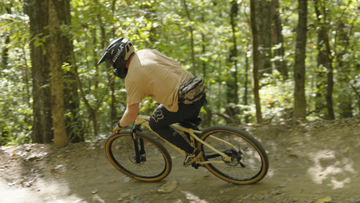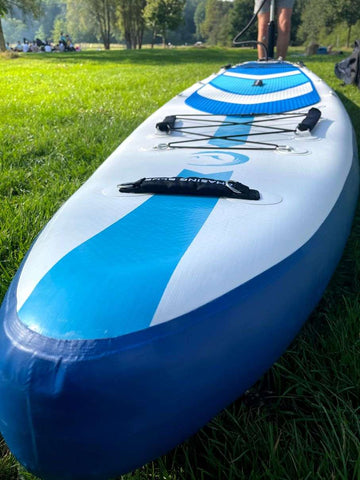You did it. You joined your friends, neighbors, co-worker, or favorite influencer, and bought a Stand Up Paddle Board (SUP). Now what? Well the obvious answer to that is you go out and hit your local water spot and enjoy yourself. But what about the equipment?
If it's inflatable do you have to put it back in the bag? If it's a solid board can you just leave it strapped to the roof of your car? Now that the paddling high is wearing off for the moment, how do you keep your paddle board in tip top shape? How do you ensure the proper return on your investment whether you spent $250 or $2,500?
Don't worry. We are going to do our best to explain the basic requirements for paddle board repair & maintenance. We will break it down in the following topics:
By the end of this article you should have a basic understanding about how to care for your SUP regardless of its composition and what to do in the case that it is damaged and in need of repairs. Do you need help RIGHT NOW? Don't worry we have a FaceBook Group where there are several mentors available to answer your specific questions. So, let's jump in!
Transport of Your Paddle Board:

Paddle boards on the van
Curtesy to Chris Murphy
Just made a paddle board purchase? Great, now what do you do? Depending on how you came to acquire your board hopefully there was a way to properly transport it offered at the time of purchase.
Purchasing from a SUP shop is always beneficial as they will be happy to sell you whatever you need to get yourself on the road. But sometimes we don't have that option or we are buying used. What then?
Well for this topic let's split this into two board classes: inflatable and hard. For inflatable boards it will probably fold down and fit in your passenger seat, backseat, or trunk. For hardboards we need to put some further thought into this action. Do you have a car or a truck? Does that car or truck have roof racks or is it bare roof? The answers are going to have a direct impact on how you can safely transport your SUP.
But first, let me make this blanket statement: DO NOT use ratcheting straps! These straps are great for securing heavy loads but the mechanical advantage of the ratchet can easily damage your SUP (hard or inflatable). Use straps that require hand tightening. Don't overtighten, just tight enough to remove most of the “wiggle” of the board.
For cars with or without roof racks we recommend the “fin forward and upward facing” setup. This provides two very distinct benefits. First in this position the leash ring can be used as a spot to attach a line to prevent the board from becoming too much of a sail. This is especially important for when you travel long distances and / or you are going at higher speeds than just around town.
Secondly, should one of the straps fail you will, theoretically, have a few moments before the board “slips away” due to its inverted fin being caught on what remains of the straps.
If your car has racks simply use straps and make sure it's securely attached to the bars. Try to get some insulation between the solid rack and the paddle board though. If your car doesn't have racks there are still options. Take straps (both front and rear) and place the paddle board fin forward and up on the roof. Put some padding between them to protect them both, such as a towel for instance.
Make sure at least the driver's door is open when you begin. You can run the straps all the way around the board and car either through the lowered windows or open doors. Remember to only tighten enough to stop wiggling of the board. This will work for short distances or emergency situations but ideally shouldn't be your go to method. Racks are available for all types of cars and trucks and they really do work well. Some don't even require the use of straps!
Ok, but what if I have a truck, can I just load it into the bed? Trucks are awesome and depending on the size of your paddle board you may very well be able to do this. Some key points to take away are to make sure that the paddle board has “padding” anywhere it comes in contact with the bed of the truck. If you are going to leave the bed down, make sure your board is tied to prevent it from falling out the back. If you have the bed up, remember not to over tighten the strap holding your board down.
Storage of Your Paddle Board:

Left in the sun, boards typically have color washed out of them. These used to be dark wood
Curtesy to Chris Murphy
You've got the board of your dreams and you've made it all the way home but it's; thundering, snowing, below freezing, anything but allowing you to go paddling. Now is a good time to think about your plans for storing your equipment.
First and foremost we will always recommend, whether you have a hard or inflatable SUP. Store it out of direct sunlight. Believe it or not, the sun is one of the most common causes for damage to paddle boards while in storage both directly and in directly.
Not only do we recommend leaving your board out of the direct sunlight but ideally in a relatively temperate area that doesn't get too hot or too cold. Heat has been proven time and time again to damage boards. Cold doesn't seem to be as damaging (we have a rental shop that leaves iSUPs outside almost all year long) BUT that doesn't mean it's not going to weaken seals, seams, or cause damage by ice forming and expanding.
Heat, on the other hand, can directly affect the chemicals and materials in your SUP or iSUP. Heat causes some of these materials to release gasses which is why most modern hard SUPs come with a vent plug.
Additionally heat causes air temperatures inside your hard SUP or iSUP to rise which also causes expansion. Bottom line, be wary of direct sunlight when the board is not being used.
Admittedly storage is easy to talk about when dealing with an inflatable paddle board, but what about the traditional solid boards? This often takes some creativity as some of us don't have the luxury of ample garage space.
We would suggest investing in a good set of paddle board racks and trying to mount them out of the way. Some boards have such a beautiful design that it's almost worth putting up on your living room wall!
Either way, remember to try to keep it stable and out of the way so it's less likely to suffer accidental damage when you or your family is in the area. If you want to know more paddle board storage tips, or how you can protect your boards better, please check out this great article that I have read before!
Cleaning Your Paddle Board:
Life is going really good right now. You've gone paddleboarding numerous times since you got your paddle board. You got your transportation method and storage method down pat (though truthfully, we are always thinking about how we can add just one more SUP to the collection).
What about cleaning your board? Whether you paddle in rivers, lakes, oceans, or streams you will encounter debris and grime that will make your paddle board look less attractive than when you first got it.
Don't worry we are here to help with some basic tips on cleaning. First and foremost, always try to wash down the board right after you paddle. It's where most of the grim and grit comes from anyways. If you're not lucky enough to live where there is convenient water side access, consider spraying it off with a hose when you return home and before you store it.
To remove any dirt and grim we recommend any paddle board safe cleaner sold by several different brands. The key you want to ensure is that whatever chemical you're using doesn't have an adverse effect on the glue or PVC used in the construction of your paddle board.
Typically, some mild dish soap is the easiest to locate around the house. Try to use a soft bristled brush to really pick away at the grime in the various nooks and crannies of the pad, and other areas prone to dirt build up.
As a last resort I have used a Mr Clean Magic Eraser, but understand that this is a mild abrasive and if used will at very least scuff the finish of your board. Sometimes, this is needed due to excessive dirt or scuff marks but again, only as a last resort.

OCEAN SPIRIT - ALL ROUND iSUP BOARD
$299.99
Repairing Your Paddle Board:
What if, despite your best efforts, the worst happens and your paddle board is damaged? Don't worry, we have some basic tips outlined here and should you need professional help, a quick search for paddle board repair near me, should at least get you started.
Our first recommendation is to always contact the manufacturer in case of damage. They will be best suited to recommending repair materials, methods, or even locations.
For solid boards it's important to assess the entire board. If one spot is visibly damaged most likely there are others as well. We recommend you feel around for any “soft spots” as that usually is the best indicator of water intrusion besides obvious breaks in the exterior.
Think of it like checking an apple for bruises. From there you will want to determine how bad the damage is and create an overall repair plan. After all, a patch here and there is not going to fix a leaking SUP.
For solid SUPs it's important to know what material yours is made out of before attempting a repair. For instance some boards are made with a plastic like exterior making their repair a very complicated ordeal. Especially if they still have a foam core center.
For most other types of boards with a paint, epoxy, and fiber construction a simple patch will often suffice. Again make sure you are using the right materials for the patch and follow the instructions. It's usually little more than taping off the damage, heavily sanding, and applying the epoxy or resin. The key with hard board repair is often patience and practice.

For inflatable boards it's a completely different story. On an inflatable paddle board there are generally two kinds of damage spots. A puncture spot or a wear spot. There is also a seam split but this is usually due to manufacturer defects (or you left your inflated iSUP in the sun all day).
So again be sure to call the manufacturer first. You never know, it might be covered under warranty! As for the other two, punctures are fairly easy. Again you will tape off the area and really try to scuff the finish of the material. Then you can apply the patch with the recommended glue. We like to use HH-66. Clamp it down and let it dry for as long as possible. We can't stress this part enough.
For a wear spot first you need to determine if it's actually leaking air. You can do this by applying soapy water and filling up the board. If water is escaping you will see the bubbles. This can also identify just how large or how many patches will be needed to repair these spots.
There is also nothing wrong with patching an area that is worn down but not yet leaking air. We typically do this on the bottom front of our boards as they are beached quite often each time they are out. Be sure to check out the Outdoor Master iSUP Repair Kit as well!

iSUP Repair Kit
$19.99
Shop NowAdditional Tips:
So we have covered most of what you will need to know to care for your stand up paddle board. There are still a few additional tidbits we would like to pass along however:
- Black boards get really really hot in the sun. I know the carbon finish on your new SUP looks amazing but please, don't leave it out in the sun or on your car. Use a board bag that has a heat reflective coating and vents so that it doesn't overheat. The results of not doing this are catastrophic and unfortunately not typically covered under warranty.
- Traveling with your inflatable paddle board inflated is perfectly OK. Use the same method of strapping as you would a hard board and remember to not over tighten the straps.
- Constantly check valves and seals. On hard boards this is typically where the heat from inside the board vents. Throw some water on it and make sure that it is consistently bubbling to regulate its heat. For inflatables check the inflation valve and make sure you have a proper valve wrench to tighten this piece. This is usually where most slow leaks start from.
- Storage is sometimes at a premium. If you have a hard board, get creative with it and you might find it looks as good in your house as it does on the water!
- If you think your board is even slightly damaged do not go out onto the water. This is both to protect yourself and to prevent the board from taking on water.
We hope that you take at least one thing away after reading this! Your stand up paddle board is a piece of equipment that needs care and maintenance just like any other.
Take the time to do it right and you should have a nice board for a long time. Check out our FaceBook Group for additional tips or to ask specific questions. You can also comment below. Till we see you on the water, Happy Paddling!














